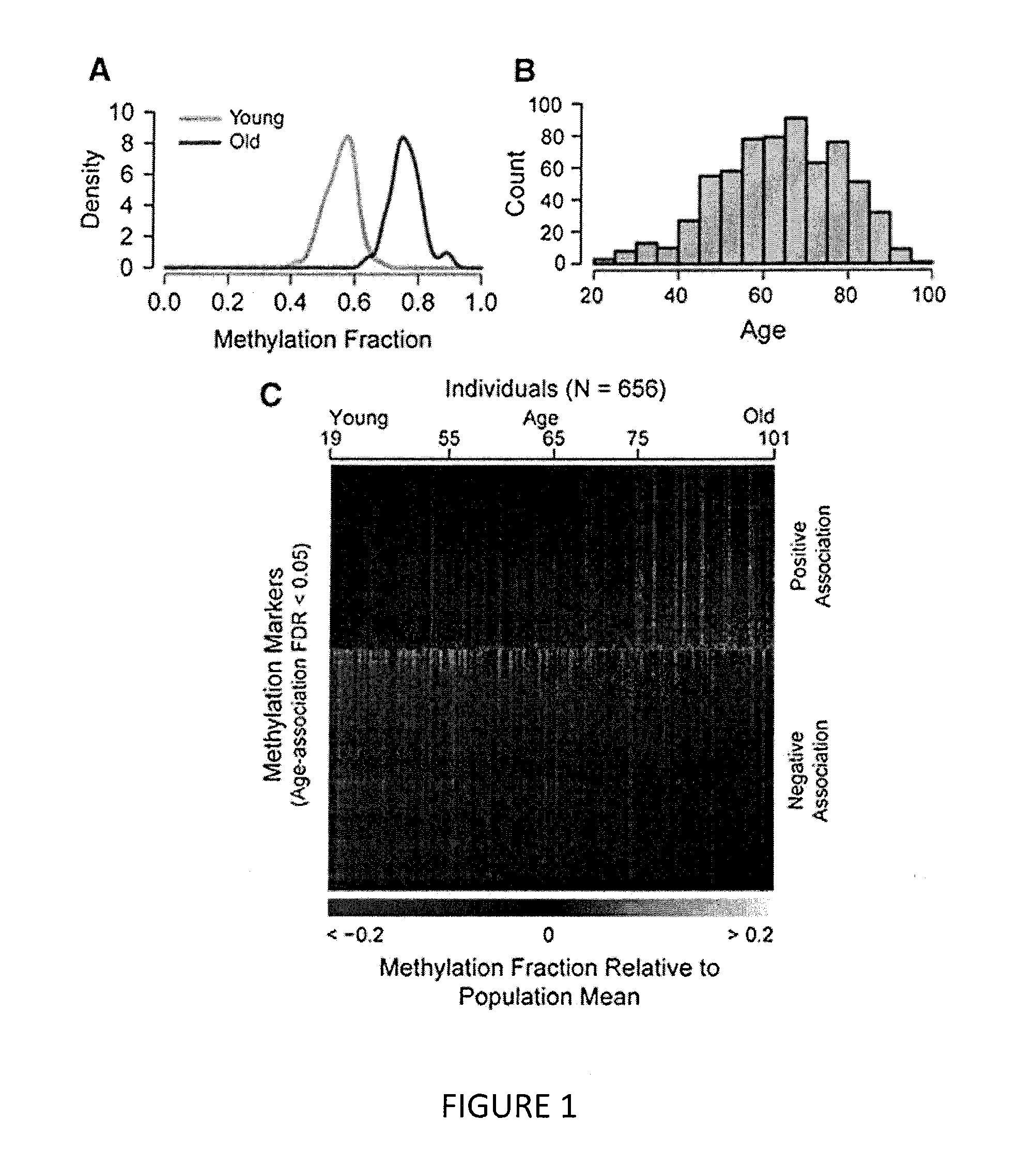Methods for predicting age and identifying agents that induce or inhibit premature aging
a technology of methylome and aging rate, which is applied in the field of predicting age and identifying agents that induce or inhibit premature aging, can solve the problems of not being able to measure and compare human aging rates, and the epigenome is not yet widely known
- Summary
- Abstract
- Description
- Claims
- Application Information
AI Technical Summary
Benefits of technology
Problems solved by technology
Method used
Image
Examples
example 1
REFERENCES FOR EXAMPLE 1
[0144]Alisch, R. S., Barwick, B. G., Chopra, P., Myrick, L. K., Satten, G. A., Conneely, K. N., and Warren, S. T. (2012). Age-associated DNA methylation in pediatric populations. Genome Res. 22, 623-632.[0145]Atzmon, G., Rincon, M., Schechter, C. B., Shuldiner, A. R., Lipton, R. B., Bergman, A., and Barzilai, N. (2006). Lipoprotein genotype and conserved pathway for exceptional longevity in humans. PLoS Biol. 4, e113.[0146]Austad, S. N. (2006). Why women live longer than men: sex differences in longevity. Gend. Med. 3, 79-92.[0147]Barres, R., and Zierath, J. R. (2011). DNA methylation in metabolic disorders. Am. J. Clin. Nutr. 93, 897S-900.[0148]Bell, J. T., Pai, A. A., Pickrell, J. K., Gaffney, D. J., Pique-Regi, R., Degner, J. F., Gilad, Y., and Pritchard, J. K. (2011). DNA methylation patterns associate with genetic and gene expression variation in HapMap cell lines. Genome Biol. 12, R10. http: / / www.ncbi.nlm.nih.gov / pubmed / 21251332.[0149]Bell, J. T., Tsai,...
example 2
Building a Methylation Model of Aging
[0199]We measured the methylation states of 485,577 CpG markers in genomic DNA collected from whole blood samples of 302 Caucasian individuals. Of these, 80 individuals had been diagnosed with type-2 diabetes, 22 of which were also characterized with diabetic nephropathy. For further study and validation, the methylation states of a second cohort were obtained, consisting of 188 Hispanic individuals. Everyone in the second cohort was diagnosed with type-2 diabetes, and 89 individuals also had diabetic nephropathy. Careful filtering and normalization was performed to remove the effects of gender, batch, and other unknown covariates.
[0200]In general, we assume biological activity will track with chronological age, allowing us to infer a biological model from chronological age. We hypothesize that changes in molecular activity from a common baseline will reflect a deceleration or acceleration of the aging process, to which disease, environment, and ...
PUM
| Property | Measurement | Unit |
|---|---|---|
| Concentration | aaaaa | aaaaa |
| Ratio | aaaaa | aaaaa |
Abstract
Description
Claims
Application Information
 Login to View More
Login to View More - R&D
- Intellectual Property
- Life Sciences
- Materials
- Tech Scout
- Unparalleled Data Quality
- Higher Quality Content
- 60% Fewer Hallucinations
Browse by: Latest US Patents, China's latest patents, Technical Efficacy Thesaurus, Application Domain, Technology Topic, Popular Technical Reports.
© 2025 PatSnap. All rights reserved.Legal|Privacy policy|Modern Slavery Act Transparency Statement|Sitemap|About US| Contact US: help@patsnap.com



